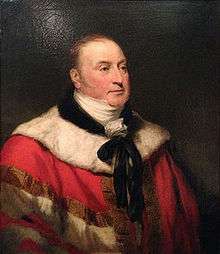George Capel-Coningsby, 5th Earl of Essex
| The Right Honourable The Earl of Essex | |
|---|---|
 Portrait from the studio of Sir Thomas Lawrence of George Capel-Conningsby, Fifth Earl of Essex | |
| Earl of Essex | |
|
In office 1799–1839 | |
| Monarch | George IV; William IV |
| Member of Parliament for Westminster 1779-80 | |
| Member of Parliament for Lostwithiel 1781-84 | |
| Member of Parliament for Okehampton 1785-90 | |
| Member of Parliament for Radnor 1794-99 | |
| Lord Lieutenant of Herefordshire 1802-17 Recorder and High Steward of Leominster 1802 | |
| Personal details | |
| Born |
13 November 1757 Watford, Hertfordshire |
| Died |
23 April 1839 Watford, Hertfordshire |
| Nationality | British |
| Known for | Commissioned the redesign of Cassiobury House |
George Capel-Coningsby, 5th Earl of Essex FSA (13 November 1757 – 23 April 1839) was an English aristocrat and politician, and styled Viscount Malden until 1799. His surname was Capell until 1781.
Origins

.
George Capell was the son and heir of William Anne Capell, 4th Earl of Essex (1732–1799), from his first marriage to Frances Williams. He was also the elder half-brother of Thomas Bladen Capel, Captain (later Admiral) in the Royal Navy and one of Horatio Nelson's Band of Brothers.
Career
_p2.114_-_Cashiobury%2C_Hertfordshore.jpg)
George Capell was educated at Corpus Christi College, Cambridge, receiving his MA in 1777. In 1781 he took the additional name of Coningsby on succeeding to the estates of his grandmother, Lady Francis Hanbury-Williams, née Coningsby.[1]
He was one of the two members of parliament for Westminster from 1779 to 1780, a member for Lostwithiel from 1781 to 1784, for Okehampton from 1785 to 1790, and for Radnor from 1794 to 1799.[1]
On 4 March 1799 Capel-Coningsby succeeded his father as 5th Earl of Essex. He served as Recorder and High Steward of Leominster in 1802, and as Lord Lieutenant of Herefordshire from 1802 to 1817. He became a Fellow of the Society of Antiquaries in 1801, and received an honorary D.C.L. from Oxford University in 1810.[1]
Upon his succession to the title of Earl of Essex, he set about a major reconstruction of the family seat, Cassiobury House in Watford, Hertfordshire, engaging the services of the architect James Wyatt and landscape designer Humphrey Repton to develop the house and grounds.[2]
Essex was noted as a major patron of the arts and was responsible for building up a large fine art collection at Cassiobury.[3] An obituary of Essex in 1839 records that "his Lordship has richly embellished his house at Cassiobury, as well as his town mansion in Belgrave Square, with numerous choice works of our native painters", and that he had entertained a number of noted British artists of the day at Cassiobury and commissioned works from them, including J. M. W. Turner, Augustus Pugin, John Callcott Horsley, David Wilkie and Edwin Henry Landseer.[4]
Marriages
George Capel-Coningsby married twice:[5]
- Firstly on 6 June 1786, as her 2nd husband, to Sarah Bazett (d.16 Jan. 1838), daughter of Henry William Bazett of Saint Helena by his marriage to Clarissa Penelope Pritchard. Sarah was a talented and prolific artist, known as "Sarah, Viscountess Malden", and from 1799 as "Sarah, Countess of Essex",[6] who specialised in making watercolour copies of old portraits and other paintings, and her surviving copies in many instances are the only evidence of the now lost originals. George outlived Sarah, who died in 1838.
- After Sarah's death, on 14 April 1838 Essex married secondly the opera singer Kitty Stephens, a daughter of Edward Stephens.
Death & burial
George Capel-Coningsby died on 23 April 1839 at Cassiobury, aged 81, and was buried at Watford,[1] leaving behind his operatic widow, Kitty Stephens, who was now the Countess Dowager.[7] Because he had no son of his own, his Earldom and estates passed to a nephew, Arthur Algernon Capell, the eldest son of his half-brother John Thomas Capell.[8]
References
- 1 2 3 4 "Capell [Capel-Coningsby], George, Viscount Malden (CPL775G)". A Cambridge Alumni Database. University of Cambridge.
- ↑ Robinson, John (2014). Felling the ancient oaks : how England lost its great country estates. [S.l.]: Aurum Pr Ltd. p. 55. ISBN 9781781313343.
- ↑ "The Cassiobury Collection". Watford Museum. Retrieved 5 December 2014.
- ↑ "Obituary: The Earl of Essex". The Gentleman's Magazine. 165-166: 652. June 1839. Retrieved 8 December 2014.
- ↑ http://www.thepeerage.com/p2972.htm#i29716
- ↑ Bridgeman Art Library
- ↑ "Miscellaneous". The Spectator. 12: 387. 27 April 1839. Retrieved 8 December 2014.
- ↑ "Arthur Algernon Capell, 6th Earl of Essex". The Peerage. Retrieved 7 December 2014.
External links
- Hansard 1803–2005: contributions in Parliament by the Earl of Essex
- "Archival material relating to Coningsby, George Capel- (1757-1839) 5th Earl of Essex". UK National Archives.
| Parliament of Great Britain | ||
|---|---|---|
| Preceded by Lord Thomas Pelham-Clinton Viscount Petersham |
Member of Parliament for Westminster 1779–1780 With: Lord Thomas Pelham-Clinton |
Succeeded by Sir George Brydges Rodney, Bt Charles James Fox |
| Preceded by Hon. Thomas de Grey George Johnstone |
Member of Parliament for Lostwithiel 1781–1784 With: George Johnstone |
Succeeded by John Sinclair John Thomas Ellis |
| Preceded by John Luxmoore Thomas Wiggens |
Member of Parliament for Okehampton 1785–1790 With: Humphrey Minchin |
Succeeded by John Hayes St Leger Robert Ladbroke |
| Preceded by David Murray |
Member of Parliament for Radnor 1794–1799 |
Succeeded by Richard Price |
| Honorary titles | ||
| Preceded by The Viscount Bateman |
Lord Lieutenant of Herefordshire 1802–1817 |
Succeeded by The Lord Somers |
| Peerage of England | ||
| Preceded by William Capell |
Earl of Essex 1799–1839 |
Succeeded by Arthur Algernon Capell |